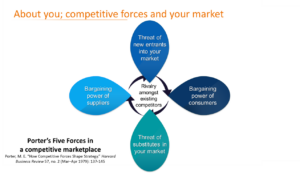News
How to Use IP Strategy to Tip the Odds in Your Favour
January 2024
Porter’s Five Forces model [1] is just one example of a convenient model for exploring and understanding the forces at play in a competitive marketplace.
Michael Porter’s Five Forces model provides us with a framework for a comprehensive understanding of the competitive landscape in the marketplace. It outlines the five key forces that shape the competitive environment, namely:
- the threat of new entrants to that market segment;
- the threat of substitute products or services;
- the bargaining power of suppliers;
- the bargaining power of buyers; and
- the intensity of rivalry among competitors in that market segment.
These forces impact the direction in which businesses aim to navigate. Without taking control of these forces, businesses can find themselves caught in a rip tide and ending up somewhere they do not want to be.
The role of Intellectual Property (IP) strategy in influencing each of those forces merits highlighting for start-ups and upscaling businesses, in particular, so that the strategic use of IP as a business tool can be fully understood. By adopting Porter’s Five Forces model as a tool for clarity around identifying market forces, in this article, I will peel back the layers on how leaders can create an IP strategy that aligns with the overall competitive strategy and the organisation’s mission and that uses IP to tip the balance in your business’ favour, especially for companies with innovation as their core differentiator and unique selling proposition (USP).
Now, let’s explore deeper into (i) what does it mean to have an Intellectual Property (IP) strategy and (ii) how can you adopt an IP strategy that aligns with your strategic direction and influences the competitive forces of the market place in a way that tips the balance in your favour? Firstly, the basics – Intellectual Property is an umbrella term covering patents, trademarks, copyright, registered and unregistered design rights; trade secrets and know-how. These are crucial intangible assets in today’s knowledge-driven economy. The aim of an IP strategy that works for you is not merely to protect your own innovations but to actively use your IP as your vital business tool to tilt the balance of the identified competitive forces in your favour.
Let’s look at the following scenario – You are aiming to enter a new market segment; of course, focus and clarity of that market segment is crucial. One of the most significant challenges any business can face are the barriers to entry to any given market segment. Well, this is where IP strategy can become your secret weapon. By owning and leveraging your IP rights, you can significantly increase those barriers for your competitors. Patents, for instance, can provide you with a monopoly over a particular technology, thereby increasing the business risks for your competitors if they wish to copy your products or processes. So, your IP can be used to deter potential new entrants by creating additional barriers to entry and as you can see, you have already impacted the forces that we mentioned already. In addition, there is of course, interconnection between these forces, so if companies protects their technology or brands to prevent copycats/similar products, it reduces the bargaining power of buyers as buyers cannot get the same product/quality at a cheaper price from your competitors without running the risk of patent infringement.
But it’s not just about building walls around your castle; it’s also about dismantling the walls of your competitors’ castle. As a new market segment entrant yourself, you will be watching your competitors carefully. By monitoring their IP, you can gain insights into their strategies and, more importantly, identify potential barriers they are trying to put up AGAINST you. With the benefit of such competitor intelligence, you can take steps to de-risk and counter their moves, reducing those barriers and ensuring a smoother entry into your chosen market. You can then further use your IP to gain time-advantage and grow and upscale your business.
In the ever-evolving business landscape, the interplay between these forces is dynamic and relentless. To stay competitive and succeed, you need to be proactive and strategic. By adopting an appropriate IP strategy, you can influence the competitive dynamics in your favour.
In conclusion, the integration of Porter’s Five Forces model with an effective Intellectual Property strategy is a potent demonstration of how you can use your IP to navigate the complexities of today’s international market place. But IP strategy is NOT a “one size fits all”, it needs to be a match for your overall business strategy. Be sure to work with a patent attorney or trade mark attorney that listens and learns about your business and then works with you to help build your IP strategy in a way that works for you in your competitive marketplace.
This article was prepared by Marie Walsh, European Patent Attorney, Partner and Dr. Jennifer Bailey, European Patent Attorney, Partner, HGF
Figure: Porter’s Five Forces in a competitive marketplace
[1] Porter, M. E. “How Competitive Forces Shape Strategy.” Harvard Business Review 57, no. 2 (Mar–Apr 1979): 137-145































